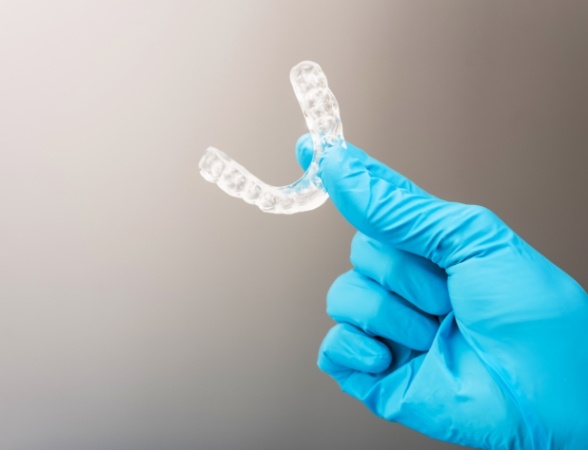TMJ Therapy – Carrollton, TX
Soothe Your
Hurting Jaw
We move our jaws countless times a day to eat and speak, so when your jaw hurts, it’s nearly impossible to escape it. Luckily, you don’t have to deal with jaw pain forever. Dr. Anthony Dillard can soothe your hurting jaw with TMJ therapy tailor-made to meet your needs. These treatments will bring you a world of relief and make your day-to-day life much easier. Contact our team at Anthony Dillard, DDS Family & Cosmetic Dentistry today to learn more about our options for TMJ therapy in Carrollton, TX!
Why Choose Anthony Dillard, DDS Family & Cosmetic Dentistry for TMJ Therapy?
- Caring Dentist with Advanced Training in TMJ Treatment
- Digital Impression System for Comfortable, Accurate Occlusal Splints
- Same-Day Dental Appointments for Emergencies
What Is TMJ?

The joints on either side of your jaw are called your temporomandibular joints, or TMJs, and they allow you to open and close your mouth and freely move your jaw in all directions. When the intricate nerves and tissue near these joints become irritated, misaligned, or injured, it can lead to TMJ disorder (TMD). At first, TMD may only cause minor discomfort, but without treatment, you could experience chronic jaw pain that worsens over time.
Causes and Symptoms of TMD

TMD can develop from a problem with the joint itself, the teeth, or both. A common cause is bruxism (chronic teeth grinding), but others include a misaligned bite, injury to the face, or even the onset of arthritis. That’s why it’s crucial for Dr. Dillard to properly diagnose TMD – it lets him treat the source rather than just manage the symptoms. Every case is different, but some of the most common TMD symptoms are:
- Pain in the jaw, ears, neck, shoulders, or head
- Difficulty opening and closing your mouth
- Clicking or popping sounds when moving your jaw
- Stiffness in your shoulders or neck
Botox® for TMJ

Well known for its ability to reduce the appearance of fine facial wrinkles, Botox is also a trusted pain reliever that can be used for a wide variety of conditions, including TMD. When injected into overactive jaw muscles, Botox can stop the unconscious movements that cause clenching and teeth grinding. This can quickly put a stop to someone’s jaw pain and headaches while also reducing the size of the mandibular muscles, creating a more attractive and natural-looking jawline.
Equilibration / Occlusal Adjustments

If bite misalignment is to blame for your TMJ disorder, then occlusal adjustments (sometimes also known as equilibration) might be just the treatment you need. After carefully reviewing your teeth and your bite’s default position, Dr. Dillard can determine exactly where pressure may be unevenly distributed. Then, he can adjust the surfaces of your teeth or restorations to even out your bite force and alleviate tension.
Occlusal Splints

Another common method of relieving TMJ pain is with a personalized oral appliance called an occlusal splint. This comfortable device gently shifts your jaw’s resting position while also preventing teeth clenching and grinding, which could worsen TMD over time. After wearing your occlusal splint to bed every night, many patients find that their TMD symptoms have permanently disappeared!
Nightguards for Bruxism

Bruxism – another word for chronic teeth grinding and jaw clenching – can affect people of all ages, and it can cause severe jaw pain and worn-down teeth if left untreated. Most people only experience this condition while they sleep, so instead of treating the grinding itself, Dr. Dillard will minimize damage by providing a custom oral appliance called a nightguard. It creates comfortable cushioning between the upper and lower rows of teeth, preventing harmful contact.
